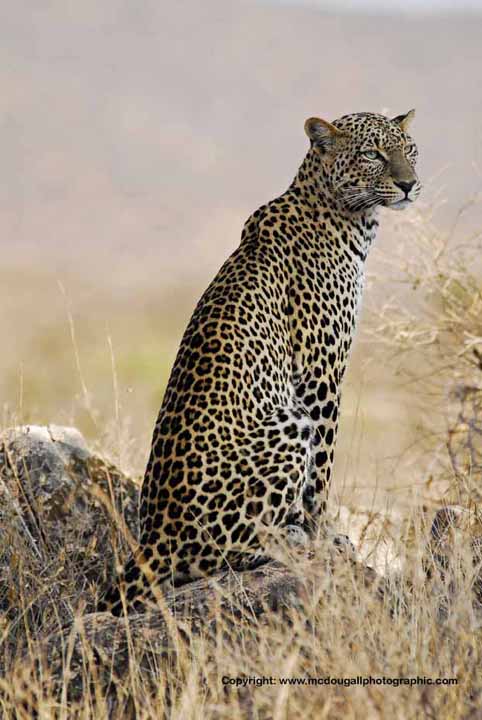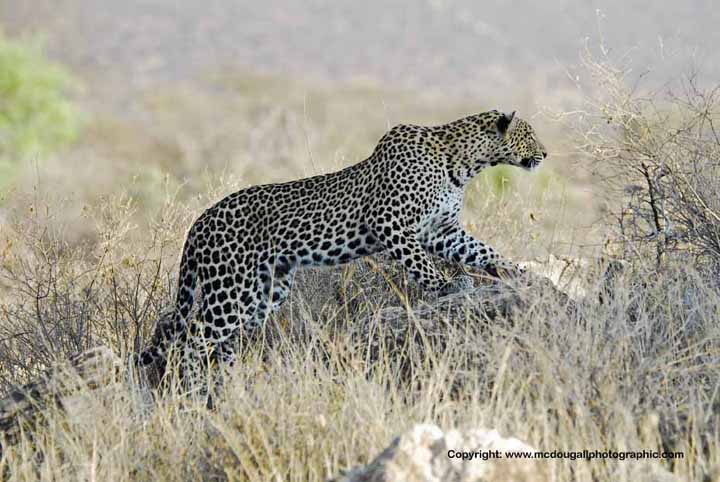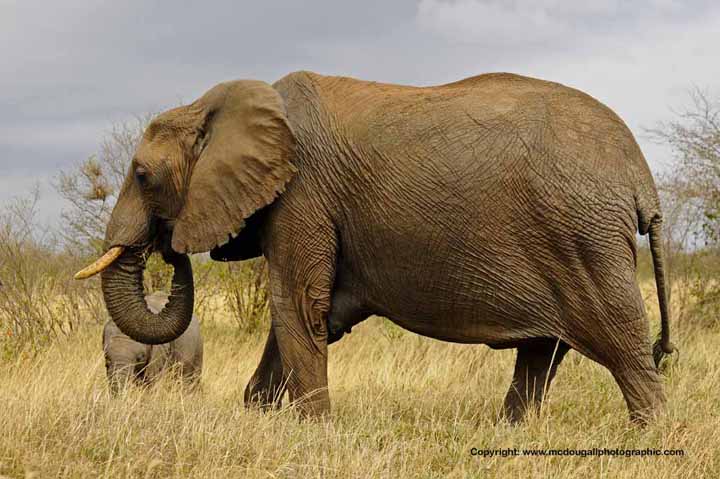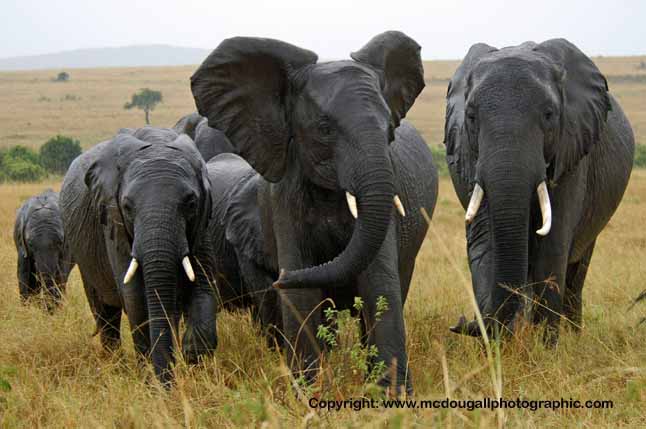Adventure
-Paul
McDougall
Leopard (Panthera pardus)

The Leopard is one of the most widely distributed cats in Africa, but also one of the hardest
to see due to its choice of dense habitat and the fact that it is generally nocturnal. The male Leopard is larger than the female but otherwise both sexes are very similar. The Leopard is a typical cat. Adults only associate long enough to mate and the young
become independent as sub-adults around 22 months. Female territories tend to overlap and they are very tolerant of their female offspring often sharing kills. Leopards are thought to copulate as many times as Lions, they can breed at 2 years and give birth
to 1-3 cubs. Leopards spend the day and part of the night inactive, draped over a tree limb or perhaps lying in a dense thicket. They move around at intervals throughout the night and for a couple of hours after dawn. Leopards although not as vocal as lions
have a very distinct call usually heard in the early evening or at dawn it is a sound very similar to someone sawing wood. A Leopard is the perfect ambush and stalking predator, it seeks to pounce before its prey can react. Leopards can consume antelopes
up to twice its weight although medium sized antelopes like Impala, Reedbuck and Thompson Gazelle form the majority of its diet. After killing its prey the Leopard usually drags it up a tree and caches it there where it returns to feed for several days. A
Leopard kill in a tree is often the closest that many safari goers will get to see this elusive cat. Despite predictions of extermination, it turns out that Leopards are far commoner than conservationists had first thought. The Leopard is successful wherever
the habitat provides reasonable cover and a variety of medium sized antelope for prey. Leopards can be seen in all of the main parks and reserves in Kenya. They are usually seen on a 3 day+ safari to Masai Mara especially around migration time. Lake Nakuru
is also very good for Leopard and has the highest density of Leopards in any Kenyan National Park or Reserve. Saiwa swamp is infamous for its black leopards although these are rarely seen.

It took me 7 years to see my first Leopard, it was always the one animal that I didn’t see on my safaris. But then my luck changed. As you can see from the photographs, I have
now been fortunate enough to get many really good sightings and opportunities to photograph this beautiful cat. My first decent Leopard sighting was in Masai Mara. I was with clients when we stopped the vehicle on a hill, Isaac started to scan the trees with
his binoculars. I stood up and started to do the same, and then through the binoculars, a movement in a big sausage tree, no it couldn’t be I thought, but then it moved again. I said to Isaac that I thought I had found a Leopard, pointed to the tree and he
looked, but he couldn’t see anything, now this guys eyes are amazing and he can spot anything. We agreed that we had time to go and check it out, and as there was a track fairly close we drove back down the hill towards the tree. As we approached – still nothing,
closer and closer, and then as we got within 50 meters of the tree, there it was a beautiful male leopard laying on the branch of the tree, as it heard us approaching, it stood up and looked at us for a few seconds before it ran down the tree and off in to
the bushes. That was my Leopard and nobody could take that away from me. I can honestly say that the adrenaline that you feel from a sighting like that is amazing. After that sighting we had 4 further sightings of different Leopard, those clients on a 2 week
safari had seen more Leopards than I had seen in 7 years of coming to Africa.

|
Adventure
|
Adventure
Elephant (Loxodanta Africana)
-Paul McDougall

The African Elephant is larger and has bigger ears than its Asian relative. Elephants can survive in virtually any habitat and are widespread throughout Kenya. Elephants are social animals and have a matriarchal society with herds of related females. Males
tend to be separate and are either alone or in male groups, their rank order is determined by seniority and reproductive condition. Female herds are made up of related individuals consisting of a mother and young with her grown daughters and their offspring.
Activity, direction and rate of movement are set by the matriarch, recognizable as the largest cow. Male elephants leave the maternal herd in adolescence (12-13 years) and after this never stay long with any cow herd. Elephants spend 16 hours a day feeding.
They can go several days without drinking, during which they can range up to 80 km from water, but drink and bathe daily by choice. An adult bull may drink 100 litres at a time and up to 227 litres a day. Elephants usually bathe after drinking, they roll and
wallow in shallows and may submerge completely in deep water. Elephants are very much contact animals. Family members often stand touching whilst resting or drinking. They lean and rub their bodies together, and often touch one another with their trunks. Elephants
vocal communication is limited to 4 different sounds but they vary the pitch, duration and volume which enables them to express a wide range of emotional states. After a 22 month gestation period females give birth to one calf. The Elephant was formerly widespread
south of the Sahara wherever water and trees occurred, but its range and numbers have shrunk as human population, development, and poaching have increased. Between 1970 and 1980 the population of East African elephants dropped by 80%. Elephants have more environmental
impact than any mammal but man. The beneficial effects (trails, wells, bringing food within reach of smaller browsers) are overshadowed by their destruction of trees, which has been spectacular in many African parks and reserves. In Tsavo, for example woodland
was transformed in to grassland, with the detriment to the elephants and many other species – especially black rhino. The root of the problem is the increasing confinement of elephants within parks. Tree destruction is a normal elephant activity and when spread
over a wide area contributes to habitat diversity and soil turnover. Elephants can be seen in Kenya in large numbers. They are particularly big in Amboseli where older elephants feed on the soft vegetation in the swamp areas allowing them to live longer than
the normal 60 years. Elephants in Samburu and Tsavo are generally a red colour, due to the dust that they cover themselves in. Another great place to see elephants in Kenya is in the Sheldrick Elephant Orphange in Nairobi, where baby elephants are taken in
as orphans and when they are old enough and well enough are re-introduced in to the wild of Tsavo NP.

I have again had many special moments with elephants; I have been in a vehicle with them so close you could touch them, I have been lucky enough to see large herds and even young calves. My most memorable has to relate to being charged though, it has happened
in Samburu, Tsavo East and Tsavo West – usually I manage to get in position to take a few photographs as the elephant runs at us, stops and throws its head and ears around in an act of defiance, mock charges are great. But one day in Tsavo East we were driving
on the dense thorny shrub road out of the park when we rounded a corner and encountered a huge bull elephant with one tusk. It took one look at us and charged, it soon became clear that this was not a mock charge. This bull meant business and although I managed
to take a few photographs as my good friend and business partner – Isaac reversed the vehicle at high speed down the road, I soon sat down and prayed that we would be able to keep ahead of it or it would loose interest. But it kept coming – we eventually rounded
a corner – giving us just enough time to turn the vehicle around and speed off, this bull followed us for a few km before we eventually managed to escape it. This was an old bull in musth, (characterized by highly aggressive behavior, accompanied by a large
rise in reproductive hormones – testosterone levels in an elephant in musth can be as much as 60 times greater than in the same elephant at other times). Not a good time to encounter it. We later found out after a very long diversion to the park gate that
this bull was also bad tempered as it had had a bad encounter with a safari vehicle a few months earlier. This is an unusual occurrence and not a normal safari experience, however it just reinforces that these are wild animals and you have to make sure that
you are with a qualified guide at all times.

|